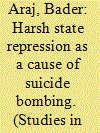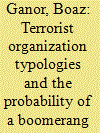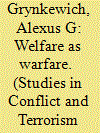| Srl | Item |
| 1 |
ID:
081346


|
|
|
|
|
| Publication |
2008.
|
| Summary/Abstract |
This article addresses a key debate within the terrorism literature-the relative importance of madrassahs for training terrorists. It argues that the two contending positions-madrassahs are not important for recruitment of terrorists and madrassahs are breeding grounds for terror are both overstated. Using a dataset constructed from Jemaah Islamiyah (JI) members, the author finds that JI-linked radical madrassah exposure is strongly associated with terrorist activity and is associated with more important roles on terrorist operations in Indonesia. The article argues that traditional scholarly theories and public debates on the importance of madrassahs are misguided because they only address top-down ideological indoctrination. The author's theory is that radical madrassahs provide a staging ground for both top-down recruitment and the creation of focal points that lead to tight knit social networks that radicalize members. In effect, they provide a "ready-made social network" for males, "give religious and ideological focus" to these groups, and provide a "particular action-oriented focus
|
|
|
|
|
|
|
|
|
|
|
|
|
|
|
|
| 2 |
ID:
081344


|
|
|
|
|
| Publication |
2008.
|
| Summary/Abstract |
Although students of social movements have established that state repression strongly affects protesters' choice of tactics, this finding has been ignored by most analysts of suicide bombing. Based on data collected from various sources, including 88 interviews the author conducted in 2006 with senior leaders of six Palestinian political organizations and close relatives and friends of Palestinian suicide bombers, this article argues that harsh state repression is a major cause of suicide bombing. It shows that understanding the effect of state repression is crucial to clarifying many of the unsolved puzzles concerning the rationales of organizations that employ suicide bombing, the motivations of individual suicide bombers, and the reasons why this tactic has become popular in some societies. The article concludes that there are three types of organizational rationales underlying the use of suicide bombing. Suicide bombing may be an extreme reaction to extreme state repression, a combined reactive and strategic action, or a purely strategic action. Different contexts and organizations typify these organizational rationales.
|
|
|
|
|
|
|
|
|
|
|
|
|
|
|
|
| 3 |
ID:
081345


|
|
|
|
|
| Publication |
2008.
|
| Summary/Abstract |
This article analyzes the motivations and recruitment of female suicide terrorists. Biographical accounts of 30 female and 30 male suicide terrorists were coded for method of recruitment, motivation for attack, and outcome of attack. A log-linear analysis found that female suicide terrorists were motivated more by Personal events, whereas males were motivated more by Religious/nationalistic factors. Females were equally likely as males to be recruited through peer influence, exploitation, or self promotion, whereas males were more likely to be recruited as a result of religious persuasion. The results highlight the need for continued research into female terrorism
|
|
|
|
|
|
|
|
|
|
|
|
|
|
|
|
| 4 |
ID:
081343


|
|
|
|
|
| Publication |
2008.
|
| Summary/Abstract |
Since the 1970s, many researchers have proposed typologies to sort the phenomenon of terror into different categories and to divide terror organizations into groups based on various characteristics of their activities. These typologies were designed to facilitate understanding of the phenomenon of terror and of terror organizations' processes, structures and operative methods. They relied on a variety of diagnostic criteria such as: motives for using terror, targets of the attacks, terrorists' demands, organizational structure; arenas of operation; and more. This article surveys major typologies of terror, notes the differences between them, presents a model to combine the different classifications of the typologies into a single typology, and proposes a new typology that sorts terror organizations by the variables that limit their activities. The proposed typology makes it possible to analyze terror organizations' behavior and even to forecast their reactions to a situation in which they are attacked by the enemy state-the boomerang effect.
|
|
|
|
|
|
|
|
|
|
|
|
|
|
|
|
| 5 |
ID:
081347


|
|
|
|
|
| Publication |
2008.
|
| Summary/Abstract |
Several violent non-state groups also administer social services. Although earlier works stress the effects of social service provision on support and sympathy for violent groups, this article emphasizes a broader challenge. Namely, social welfare organizations threaten to rob the state of the legitimacy it derives through the social contract. Abolishing these organizations can cause humanitarian crises, radicalize populations, and erode domestic and international policy support. Ignoring them invites the continued erosion of state power. The way out of this dilemma is through a strategy of "displacement," whereby the state eradicates non-state social services while concurrently extending its own welfare capacity
|
|
|
|
|
|
|
|
|
|
|
|
|
|
|
|